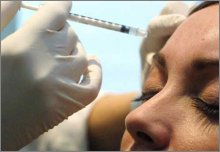Botox: They Say it's Safe, But Here
is Why You Need to Beware
by www.SixWise.com
In 2007, Botox topped the list of the most popular nonsurgical
cosmetic procedures, with nearly 2.8 million treatments in
the United States alone.
|

Nearly 3 million people received Botox treatments in
2007 to remove the wrinkles between their eyebrows.
|
Most widely known as a treatment to get rid of wrinkles or
frown lines between your eyebrows, Botox is made from botulinum
toxin type A, which is the same toxin that causes botulism
food poisoning.
When injected into your forehead, Botox blocks nerve cells'
release of a chemical called acetylcholine, which signals
muscle contraction. As a result, the injections interfere
with your muscles' ability to contract, causing existing frown
lines to smooth out and disappear in about a week.
Botox is also approved to treat eye muscle disorders, excessive
underarm sweating, and cervical dystonia, a neurological movement
disorder that causes neck and shoulder spasms. It was actually
after using Botox in the treatment of an eye disorder that
its wrinkle-removing "side effect" was discovered.
New Warnings From the FDA
Though millions of Americans receive regular Botox injections,
even going so far as to organize "Botox parties,"
new concerns have surfaced over its safety.
In February 2008, the U.S. Food and Drug Administration (FDA)
warned that Botox and its competitor Myobloc have been linked
to dangerous botulism symptoms, including a few deaths in
children.
|

In rare cases, the toxin in Botox may spread to other
areas of your body, paralyzing muscles and causing trouble
breathing and swallowing.
|
They warned that in "rare cases" the toxin can
spread beyond the injection site, causing paralysis and weakness
in muscles used for breathing and swallowing, a condition
that can be deadly. The FDA is investigating several deaths,
most of which involve children who were treated with Botox
for cerebral palsy-related leg spasms.
The agency is also investigating reports of illnesses linked
to Botox, including at least one woman who was hospitalized
after receiving Botox injections for wrinkles.
According to the FDA, anyone who receives Botox should be
aware of the symptoms of botulism, which include:
"I think people should be aware there's a potential
for this to happen," said Dr. Russell Katz, FDA's neurology
chief in CNN. "People should be on the lookout for it."
Public Citizen Also Urges Stricter Warnings
Consumer advocacy group Public Citizen has also asked the
FDA to "immediately increase its warnings and directly
warn patients and doctors about the use of botulinum toxin."
The request follows their analysis of FDA data that found
between Nov. 1, 1997, and Dec. 31, 2006 there were 658 reported
cases of people suffering adverse effects from injections
of botulinum toxin.
Of these, 180 were associated with paralysis of respiratory
muscles and difficulty swallowing, or pneumonia, 87 required
hospitalization, and 16 people died.
"Nobody should be dying from injected botulinum toxin,"
said Dr. Sidney Wolfe, director of Public Citizen's Health
Research Group. "Educating physicians and patients about
what adverse symptoms to look for and when to seek immediate
medical attention will save lives."
If you choose to receive Botox for cosmetic purposes, be
sure you have chosen an experienced health care practitioner
for the treatment. The FDA recommends that the lowest effective
dose be used, and that you receive injections no more than
once every three months.
Also, be on the lookout for the serious symptoms described
above, along with some of the other common side effects, which
include:
If you notice any of the above symptoms following a Botox
treatment, you should see your health care provider immediately.
Recommended Reading
Why
Your Face Ages, and How to Avoid Premature Aging
Aging
Gracefully: Enjoy a Vital, Fulfilling Life Regardless of Age
Sources
CNN.com
February 8, 2008
Public
Citizen January 24, 2008